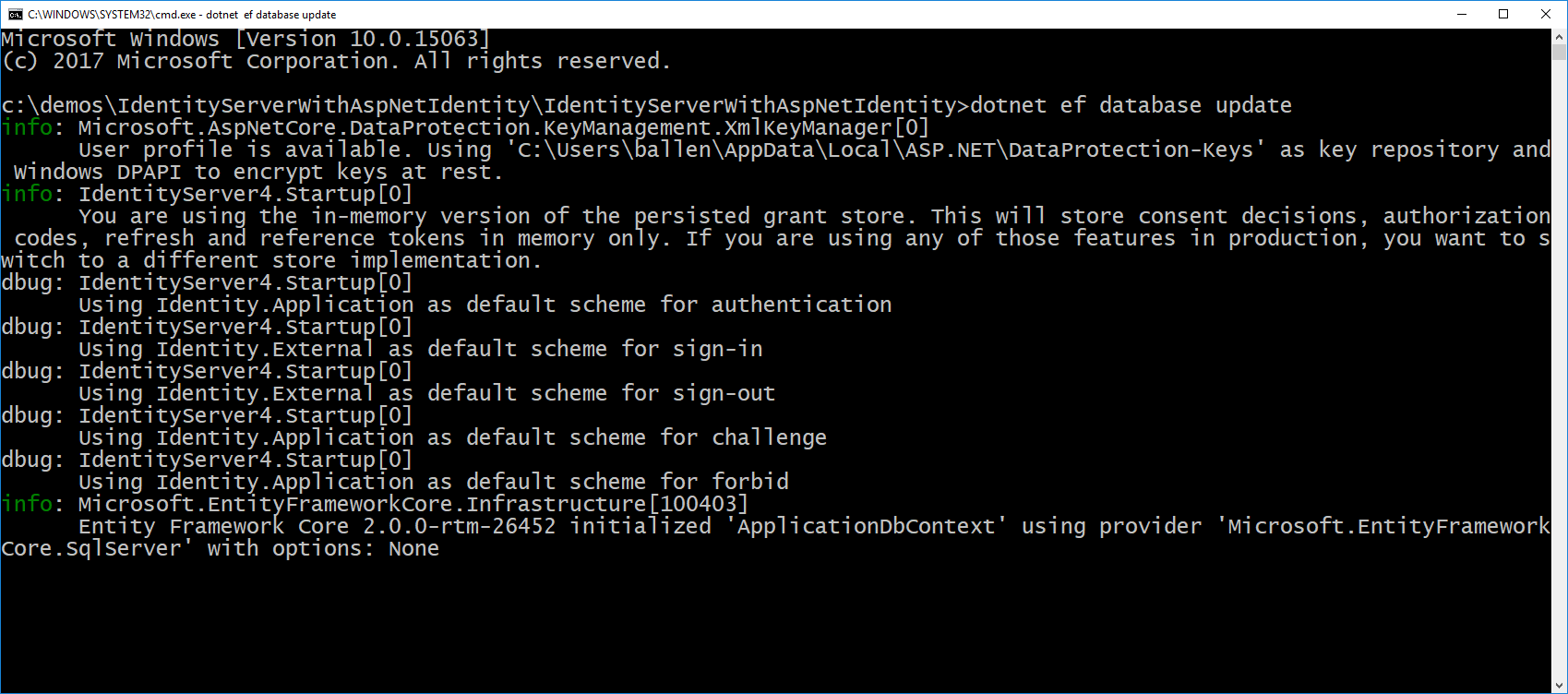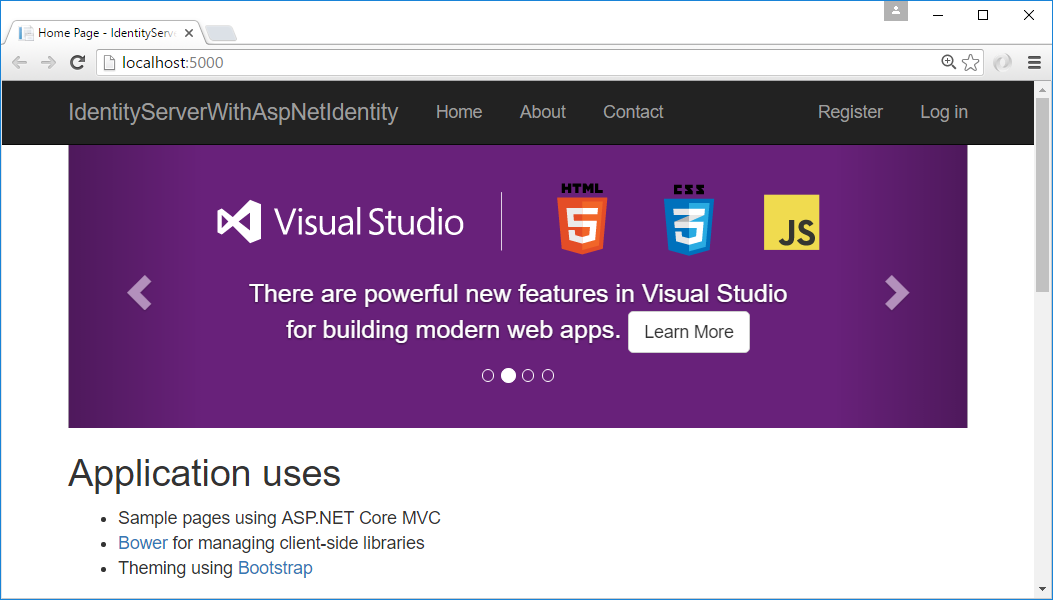IdentityServer(12)- 使用 ASP.NET Core Identity
IdentityServer具有非常好的扩展性,其中用户及其数据(包括密码)部分你可以使用任何想要的数据库进行持久化。 如果需要一个新的用户数据库,那么ASP.NET Core Identity是你的一个选择。 本快速入门介绍了如何将ASP.NET Core Identity 和 IdentityServer4一起使用。
在阅读这篇文章是,希望你能把前面的文章全部看一遍,了解基本使用和相关的理论。 这个快速入门使用ASP.NET Core Identity的方法是从Visual Studio中的ASP.NET Core Identity模板创建一个新项目。 这个新的项目将取代之前在之前的快速入门中从头开始构建的IdentityServer项目。 此解决方案中的所有其他项目(对于客户端和API)将保持不变。
建立ASP.NET Identity新项目
第一步是为您的解决方案添加一个ASP.NET Core Identity的新项目。 鉴于ASP.NET Core Identity需要大量代码,因此使用Visual Studio中的模板是最好的。 你最终将删除IdentityServer的旧项目,但有几个项目需要迁移(或按照之前的快速入门所述从头开始重新编写)。
创建一个ASP.NET Core Web应用程序
然后选择Web应用程序(MVC)
然后点击“更改身份验证”按钮,选择“个人用户账户”
最后,你的设置应该是和下图一样:
修改hosting
不要忘记修改hosting以在端口5000上运行。这非常重要,这将关系到继续使用现有的客户端和API项目。
添加IdentityServer组件
添加IdentityServer4.AspNetIdentity NuGet包。
Scopes 和 Clients 配置
尽管这是IdentityServer的一个新项目,但我们仍然需要与之前的快速入门一样的配置Scopes 和 Clients。 将之前快速入门的配置类(在Config.cs中)复制到此新项目中。
对于现在的配置需要改变的是禁用MVC客户端的许可。 我们还没有复制之前的IdentityServer项目的许可代码,所以现在对MVC客户端进行一次修改,并设置RequireConsent = false:
new Client
{
ClientId = "mvc",
ClientName = "MVC Client",
AllowedGrantTypes = GrantTypes.HybridAndClientCredentials,
RequireConsent = false,
ClientSecrets =
{
new Secret("secret".Sha256())
},
RedirectUris = { "http://localhost:5002/signin-oidc" },
PostLogoutRedirectUris = { "http://localhost:5002/signout-callback-oidc" },
AllowedScopes =
{
IdentityServerConstants.StandardScopes.OpenId,
IdentityServerConstants.StandardScopes.Profile,
"api1"
},
AllowOfflineAccess = true
}
配置IdentityServer
和以前一样,IdentityServer需要在Startup.cs的ConfigureServices和Configure中进行配置。
ConfigureServices:
以前我们使用AddTestUsers扩展方法用于注册用户,但在这种现在的解决方案下,我们用AddAspNetIdentity替换该扩展方法来使用ASP.NET Identity用户。AddAspNetIdentity扩展方法需要一个通用参数,它是你的ASP.NET Ientity用户类型(与模板中的AddIdentity方法一样)
public void ConfigureServices(IServiceCollection services)
{
services.AddDbContext<ApplicationDbContext>(options =>
options.UseSqlServer(Configuration.GetConnectionString("DefaultConnection")));
services.AddIdentity<ApplicationUser, IdentityRole>()
.AddEntityFrameworkStores<ApplicationDbContext>()
.AddDefaultTokenProviders();
// Add application services.
services.AddTransient<IEmailSender, EmailSender>();
services.AddMvc();
// configure identity server with in-memory stores, keys, clients and scopes
services.AddIdentityServer()
.AddDeveloperSigningCredential()
.AddInMemoryPersistedGrants()
.AddInMemoryIdentityResources(Config.GetIdentityResources())
.AddInMemoryApiResources(Config.GetApiResources())
.AddInMemoryClients(Config.GetClients())
.AddAspNetIdentity<ApplicationUser>();
}
我们在将Asp.Net Identity添加到DI容器中时,一定要把注册IdentityServer放在Asp.Net Identity之后,因为注册IdentityServer会覆盖Asp.Net Identity的一些配置,这个非常重要。
Configure
使用UseIdentityServer代替了对UseIdentity的调用
public void Configure(IApplicationBuilder app, IHostingEnvironment env)
{
if (env.IsDevelopment())
{
app.UseDeveloperExceptionPage();
app.UseBrowserLink();
app.UseDatabaseErrorPage();
}
else
{
app.UseExceptionHandler("/Home/Error");
}
app.UseStaticFiles();
// app.UseAuthentication(); // not needed, since UseIdentityServer adds the authentication middleware
app.UseIdentityServer();
app.UseMvc(routes =>
{
routes.MapRoute(
name: "default",
template: "{controller=Home}/{action=Index}/{id?}");
});
}
创建用户数据库
鉴于这是一个新的ASP.NET Identity项目,您将需要创建数据库。 您可以通过从项目目录运行命令提示符并运行dotnet ef database update -c ApplicationDbContext来完成此操作:
在VS程序包控制台使用命令也是一样的
Update-Database
创建用户
此时,您应该能够运行项目并在数据库中创建/注册用户。 启动应用程序,并从主页点击“Register”链接:
并在注册页面上创建一个新的用户帐户:
现在你有一个用户帐户,你应该可以登录,使用客户端,并调用API。
在MVC客户端登录
启动MVC客户端应用程序,你应该能够点击“Secure”链接登录。
您应该被重定向到ASP.NET Identity登录页面。 用新创建的用户登录:
登录后,您应该跳过同意页面(给出我们上面所做的更改),并立即重定向到MVC客户端应用程序,会显示你的用户信息。
您还应该能够单击“Call API using application identity”来调用API:
现在,您已经从ASP.NET Ientity的用户登录。
本文代码:https://github.com/IdentityServer/IdentityServer4.Samples/tree/master/Quickstarts/8_AspNetIdentity
原文:https://identityserver4.readthedocs.io/en/latest/quickstarts/8_aspnet_identity.html
额外,同时使用ASP.NET Identity和EF的示例请看:https://github.com/IdentityServer/IdentityServer4.Samples/tree/master/Quickstarts/Combined_AspId_and_EFStorage
作者:晓晨Master(李志强)
出处:https://www.cnblogs.com/stulzq/p/8120129.html
版权:本作品采用「署名-非商业性使用-相同方式共享 4.0 国际」许可协议进行许可。
目前学习.NET Core 最好的教程 .NET Core 官方教程 ASP.NET Core 官方教程
















【推荐】国内首个AI IDE,深度理解中文开发场景,立即下载体验Trae
【推荐】编程新体验,更懂你的AI,立即体验豆包MarsCode编程助手
【推荐】抖音旗下AI助手豆包,你的智能百科全书,全免费不限次数
【推荐】轻量又高性能的 SSH 工具 IShell:AI 加持,快人一步
· 开发者必知的日志记录最佳实践
· SQL Server 2025 AI相关能力初探
· Linux系列:如何用 C#调用 C方法造成内存泄露
· AI与.NET技术实操系列(二):开始使用ML.NET
· 记一次.NET内存居高不下排查解决与启示
· 被坑几百块钱后,我竟然真的恢复了删除的微信聊天记录!
· 没有Manus邀请码?试试免邀请码的MGX或者开源的OpenManus吧
· 【自荐】一款简洁、开源的在线白板工具 Drawnix
· 园子的第一款AI主题卫衣上架——"HELLO! HOW CAN I ASSIST YOU TODAY
· Docker 太简单,K8s 太复杂?w7panel 让容器管理更轻松!